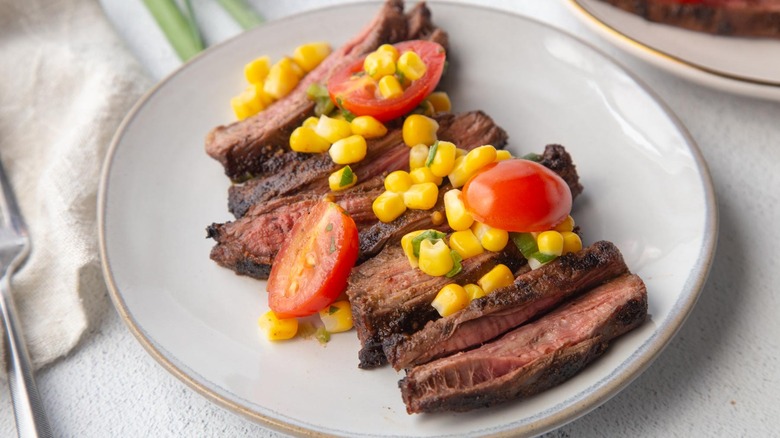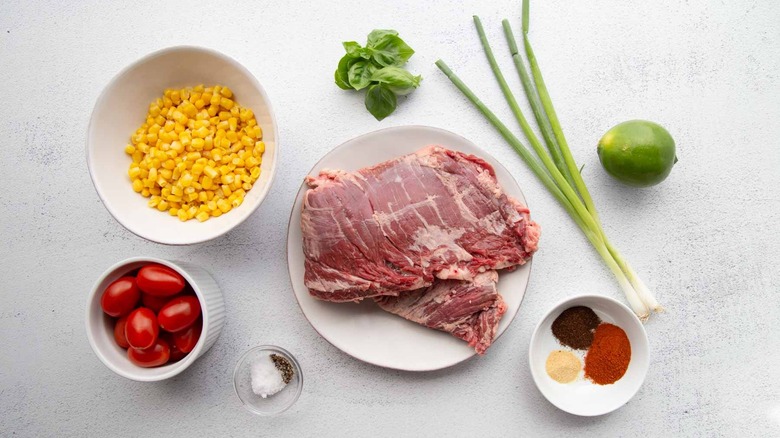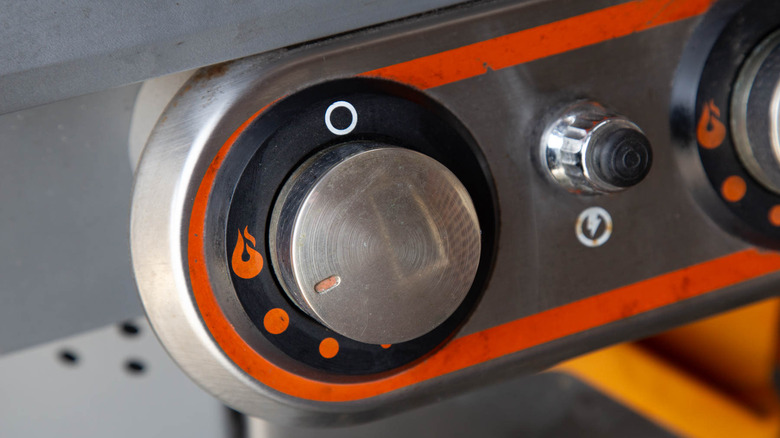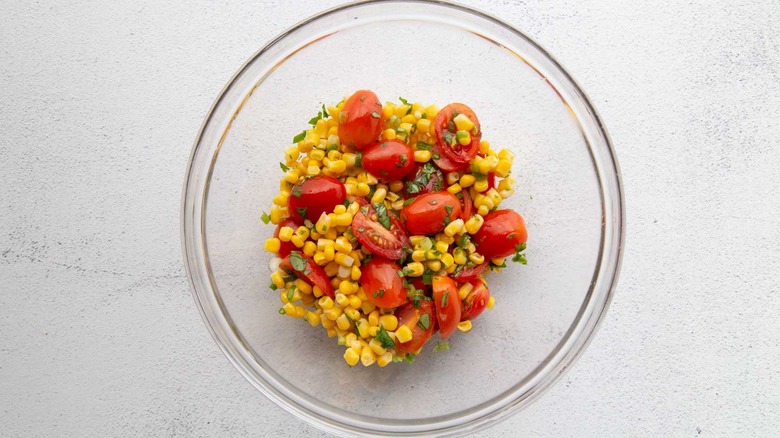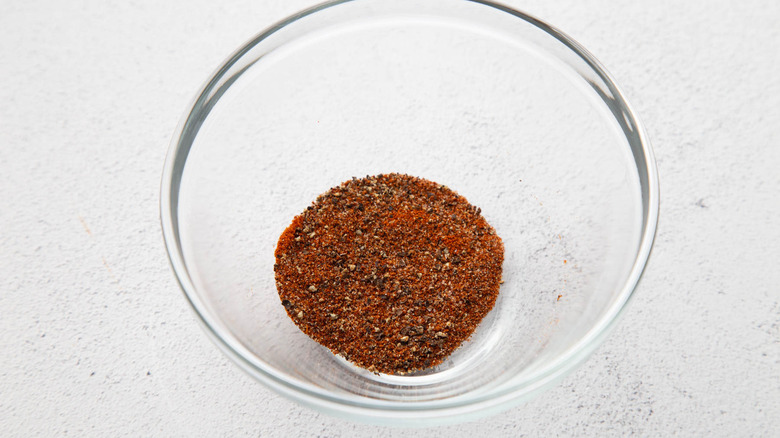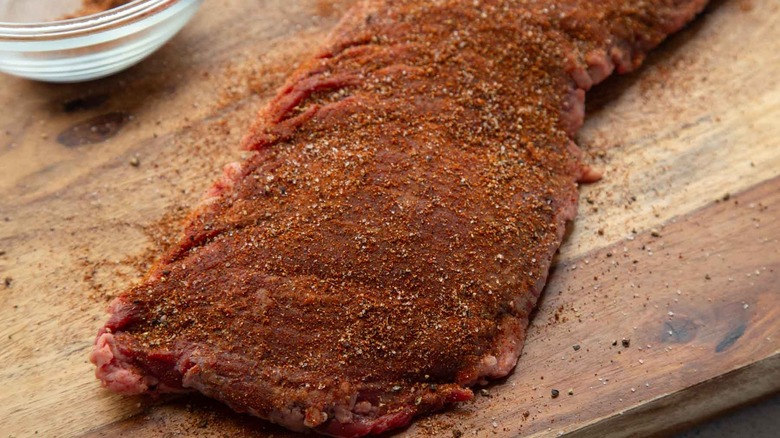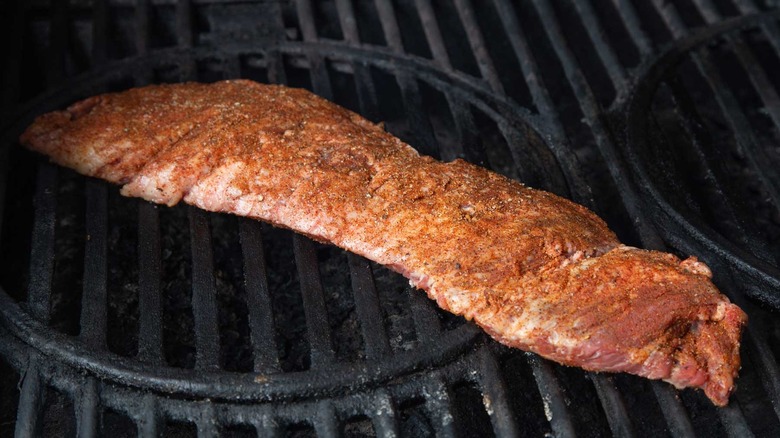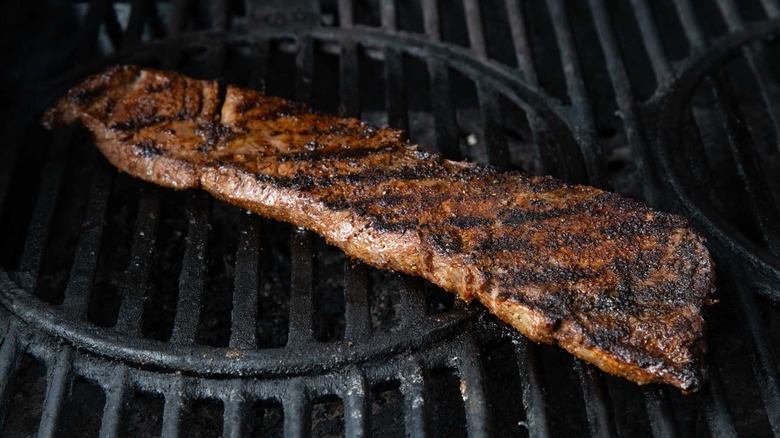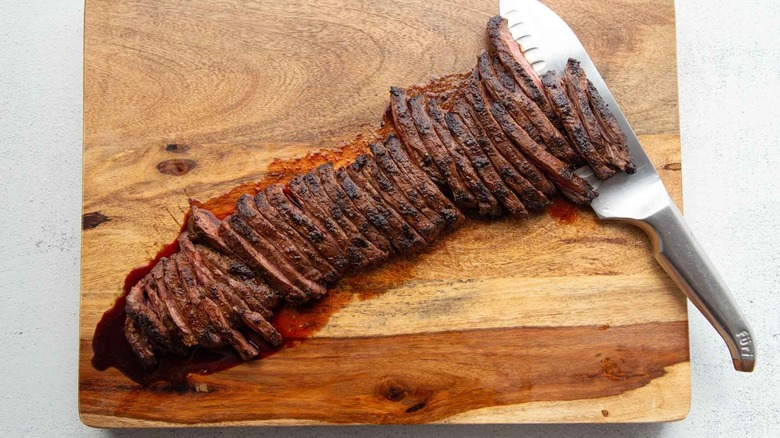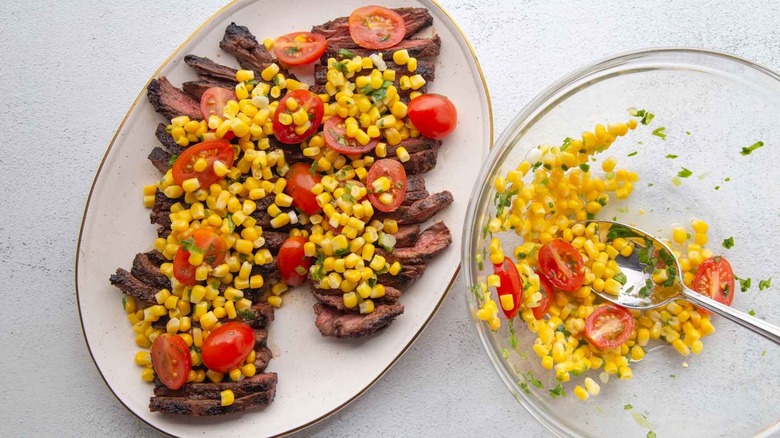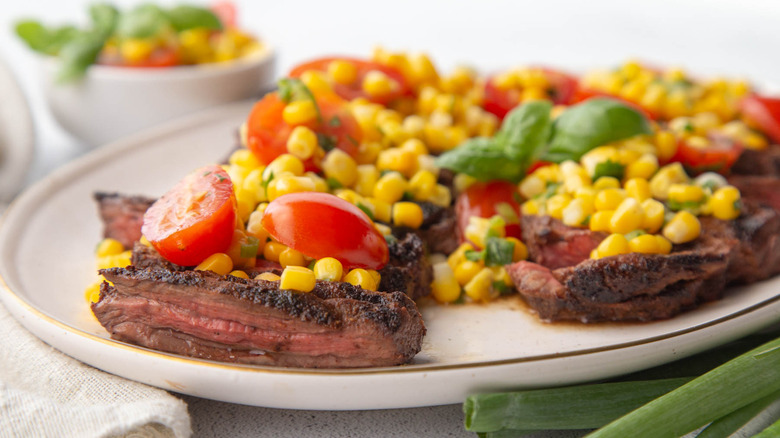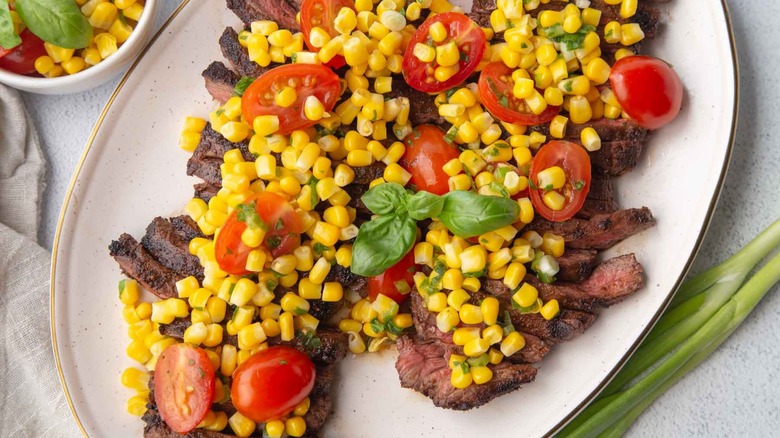Grilled Skirt Steak With Corn And Tomato Salsa Recipe
Juicy and full of beefy flavor, skirt steak needs little help in the flavor department. Even so, all meat deserves a little dressing up every once in awhile. This recipe for grilled skirt steak with corn and tomato salsa, developed by Kate Shungu, is a simple way to jazz up an already-flavorful skirt steak. "I love serving this dish when the weather is warm," Shungu says. "It has the flavors of summer (grilled meat, fresh tomatoes, corn), and you don't even have to turn on your oven to make it. Just season and grill the meat, mix the salsa, and dinner is done."
While Shungu prefers to grill the meat, the skirt steak can also be cooked on an indoor grill pan. Either way, the key to a perfectly cooked skirt steak is a searing-hot cooking surface. When the meat hits the pan, the grill marks and flavors start developing. Since this cut of meat is quite thin, it takes just minutes for the steak to be ready. As a result, we recommend mixing the salsa before grilling the meat. You can even make the salsa up to one day in advance for an even easier prep time once dinner rolls around.
Gather the ingredients for grilled skirt steak with corn and tomato salsa
A simple dry rub on skirt steak really elevates the meat. We'll use a mixture of smoked paprika, ancho chile powder, garlic powder, salt, and pepper to season the skirt steak before grilling. The tomato and corn salsa consists of grape tomatoes (any type of tomatoes work well), corn, green onions, lime juice, and fresh basil. For the corn, you can use corn fresh off the cob, frozen corn, or canned corn.
Step 1: Heat the grill
Preheat the grill to medium-high heat.
Step 2: Mix the salsa
In a medium bowl, stir together the corn kernels, tomatoes, green onions, lime juice, and fresh basil. Sprinkle with ¼ teaspoon salt and set aside.
Step 3: Prepare the dry rub
In a small bowl, stir together the smoked paprika, chile powder, garlic powder, remaining 1 teaspoon salt, and black pepper.
Step 4: Season the steak
Place the skirt steak on a work surface. Sprinkle the seasoning over the steak evenly.
Step 5: Grill the skirt steak
Place the steak on the grill for 2–3 minutes, or until it releases easily.
Step 6: Continue grilling the skirt steak
Flip and continue cooking for another 2–3 minutes, or until your desired doneness is reached.
Step 7: Slice the steak
Let the steak rest for 5 minutes before cutting it into thin slices.
Step 8: Top with salsa, and serve
Place the sliced steak on a serving platter and top with the corn salsa. Serve immediately.
Grilled Skirt Steak With Corn and Tomato Salsa Recipe
A simple, smoky spice rub coats tender skirt steak before you grill it up, and then you'll top the meat with a summery, corn-and-tomato salsa.
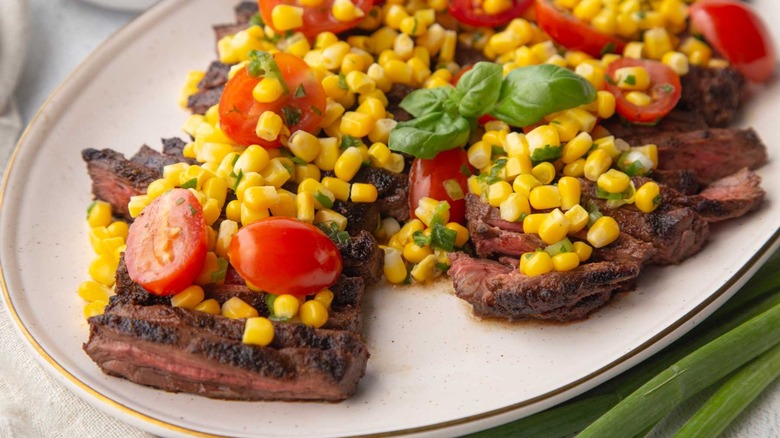
Ingredients
- 1 ½ cups corn kernels
- 1 heaping cup grape tomatoes, halved
- 2 green onions, sliced
- 1 lime, juiced
- 2 tablespoons chopped fresh basil
- 1 ¼ teaspoons salt, divided
- 2 teaspoons smoked paprika
- 1 teaspoon ancho chile powder
- ½ teaspoon garlic powder
- ½ teaspoon ground black pepper
- 1 ¼ pounds skirt steak
Directions
- Preheat the grill to medium-high heat.
- In a medium bowl, stir together the corn kernels, tomatoes, green onions, lime juice, and fresh basil. Sprinkle with ¼ teaspoon salt and set aside.
- In a small bowl, stir together the smoked paprika, chile powder, garlic powder, remaining 1 teaspoon salt, and black pepper.
- Place the skirt steak on a work surface. Sprinkle the seasoning over the steak evenly.
- Place the steak on the grill for 2–3 minutes, or until it releases easily.
- Flip and continue cooking for another 2–3 minutes, or until your desired doneness is reached.
- Let the steak rest for 5 minutes before cutting it into thin slices.
- Place the sliced steak on a serving platter and top with the corn salsa. Serve immediately.
Nutrition
| Calories per Serving | 358 |
| Total Fat | 19.3 g |
| Saturated Fat | 7.3 g |
| Trans Fat | 1.0 g |
| Cholesterol | 92.1 mg |
| Total Carbohydrates | 18.9 g |
| Dietary Fiber | 3.2 g |
| Total Sugars | 3.4 g |
| Sodium | 603.2 mg |
| Protein | 31.4 g |
How can you tell when skirt steak is cooked?
Skirt steak is a thin cut of meat, so it's important to have the tools and know-how to avoid overcooking it. The ideal texture of skirt steak is slightly chewy (after all, this isn't filet mignon) but still tender and melt in your mouth. While a meat thermometer is a surefire way to cook skirt steak to your desired doneness, there's a way to do it without any tools.
If you're using a meat thermometer, we recommend cooking the meat to 130 F. After a five-minute rest, the temperature will hit 135 F for a perfectly medium-rare texture. If you desire more or less doneness, just add or subtract five degrees. Take the steak off the grill at 135 F for medium, 140 F for medium-well, etc. Rare meat lovers can take the steak off the grill at 125 F.
No meat thermometer? No problem. Open your left palm and find the pad under your thumb. It's right beneath where your thumb meets your palm. Touch your left thumb to your left index finger. Using your right hand, touch the thumb pad. That's what rare meat will feel like when pressed with a finger. Now, touch your thumb to your middle finger. Touch the thumb pad again with your other hand — that's what medium-rare feels like. Continue down your hand until you reach your pinkie, which is what well-done steak feels like.
Which is better, inside or outside skirt steak?
While skirt steak and flank steak are frequently compared, there's even more nuance in a skirt steak: Is it an inside skirt steak or an outside skirt steak? You'll be able to spot the difference when the two are placed side by side. An inside skirt steak is shorter and very thin. An outside skirt steak can be almost twice as long and up to one-inch thick.
Which variety you use depends on the dish and your budget. Outside skirt steak is more tender, and therefore it is typically a dollar or two more per pound than inside skirt steak. Inside skirt steak is chewier and less tender, but sometimes you want a thin cut of meat. Applications for inside skirt steak include steak tacos or fajitas, where you don't want to have big chunks of meat tearing up the tortilla.
For this dish and others, such as this herby skirt steak, we recommend using outside skirt steak. Its thickness makes it more substantial, and you can never go wrong with a more tender cut of beef (as long as it's cooked correctly).
